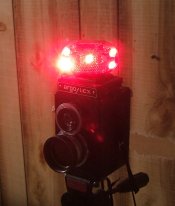I have a lot of these red LED clip on taillights from my old bikes. Can they be used as darkroom safelights? They're pretty darned bright, but you can disable the individual bulbs one by one in the taillight to get less light.
I'm not real familiar w/ proper red LED safelights, but these are clear when they're off, then give off red light when you give 'em the juice. They appear white in the photo, but it's just how my little digicam captured them. Not sure why the camera didn't "see" that to my eye, the light is totally red, which has me concerned about their usefulness in a darkroom.

I'm not real familiar w/ proper red LED safelights, but these are clear when they're off, then give off red light when you give 'em the juice. They appear white in the photo, but it's just how my little digicam captured them. Not sure why the camera didn't "see" that to my eye, the light is totally red, which has me concerned about their usefulness in a darkroom.

Last edited by a moderator:










